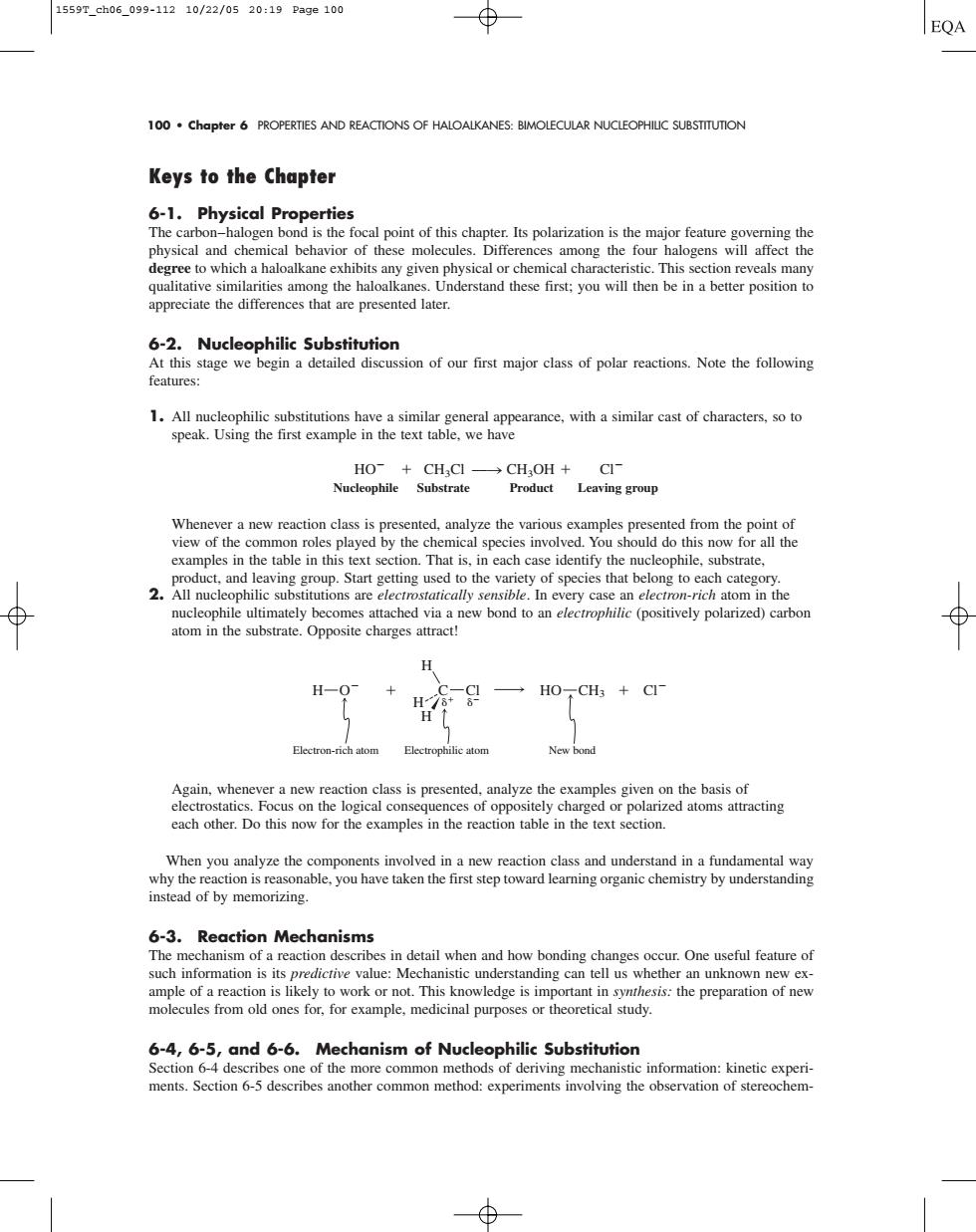正在加载图片...

15597.ch06_099-11210/22/0520:19Page100 EQA 100 chapter 6 PROPERTES AND REACTIONS OF HALOALKANES:BIMOLECULAR NUCLEOPHILIC SUBSTTTUTON Keys to the Chapter ng the appre 6-2.Nucleophilic Substitution At this stage we begin a detailed discussion of our first major class of polar reactions.Note the following features csubstitutions have a similar general appearance,with a similar cast of characters.so to Nucleophile Substrate Whenever a new reaction class is p esented.analyze the various examples p sented from the point of view of the common roles played by the chemical species involved.You should do this now for all the in the ta in this stan strate ybecomesaond to (positiely polanzed)caon Electron-richom Electrophilic atom each other.Do this now for the examples in the reaction table in the text section. on class and understand in a fundamental way s organic chemistr y by understandin instead of by memorizing. 6-3.Reactio Mecha100 • Chapter 6 PROPERTIES AND REACTIONS OF HALOALKANES: BIMOLECULAR NUCLEOPHILIC SUBSTITUTION Keys to the Chapter 6-1. Physical Properties The carbon–halogen bond is the focal point of this chapter. Its polarization is the major feature governing the physical and chemical behavior of these molecules. Differences among the four halogens will affect the degree to which a haloalkane exhibits any given physical or chemical characteristic. This section reveals many qualitative similarities among the haloalkanes. Understand these first; you will then be in a better position to appreciate the differences that are presented later. 6-2. Nucleophilic Substitution At this stage we begin a detailed discussion of our first major class of polar reactions. Note the following features: 1. All nucleophilic substitutions have a similar general appearance, with a similar cast of characters, so to speak. Using the first example in the text table, we have HO CH3Cl 88n CH3OH Cl Nucleophile Substrate Product Leaving group Whenever a new reaction class is presented, analyze the various examples presented from the point of view of the common roles played by the chemical species involved. You should do this now for all the examples in the table in this text section. That is, in each case identify the nucleophile, substrate, product, and leaving group. Start getting used to the variety of species that belong to each category. 2. All nucleophilic substitutions are electrostatically sensible. In every case an electron-rich atom in the nucleophile ultimately becomes attached via a new bond to an electrophilic (positively polarized) carbon atom in the substrate. Opposite charges attract! Again, whenever a new reaction class is presented, analyze the examples given on the basis of electrostatics. Focus on the logical consequences of oppositely charged or polarized atoms attracting each other. Do this now for the examples in the reaction table in the text section. When you analyze the components involved in a new reaction class and understand in a fundamental way why the reaction is reasonable, you have taken the first step toward learning organic chemistry by understanding instead of by memorizing. 6-3. Reaction Mechanisms The mechanism of a reaction describes in detail when and how bonding changes occur. One useful feature of such information is its predictive value: Mechanistic understanding can tell us whether an unknown new example of a reaction is likely to work or not. This knowledge is important in synthesis: the preparation of new molecules from old ones for, for example, medicinal purposes or theoretical study. 6-4, 6-5, and 6-6. Mechanism of Nucleophilic Substitution Section 6-4 describes one of the more common methods of deriving mechanistic information: kinetic experiments. Section 6-5 describes another common method: experiments involving the observation of stereochemO Cl H H H H C Cl HO CH3 Electron-rich atom Electrophilic atom New bond 1559T_ch06_099-112 10/22/05 20:19 Page 100����������